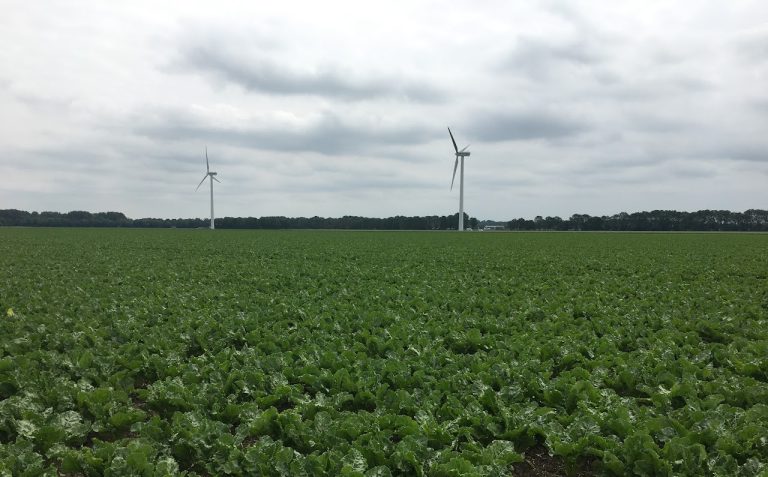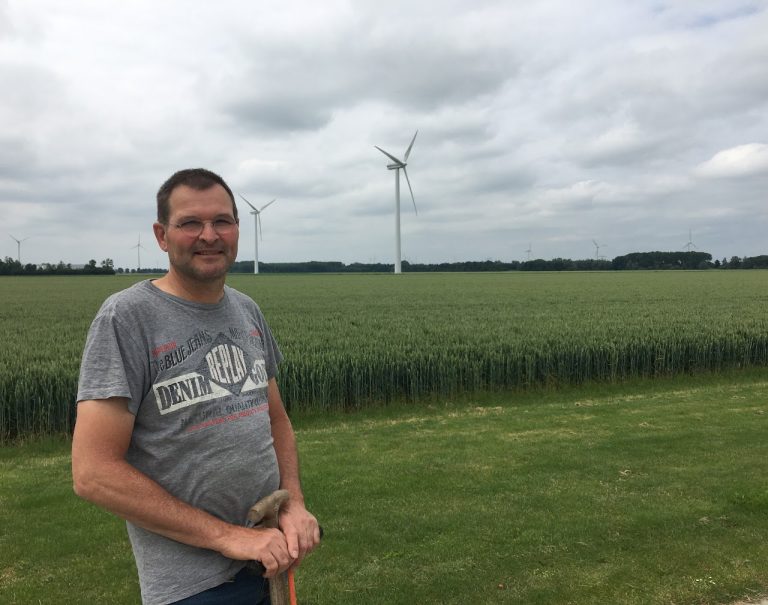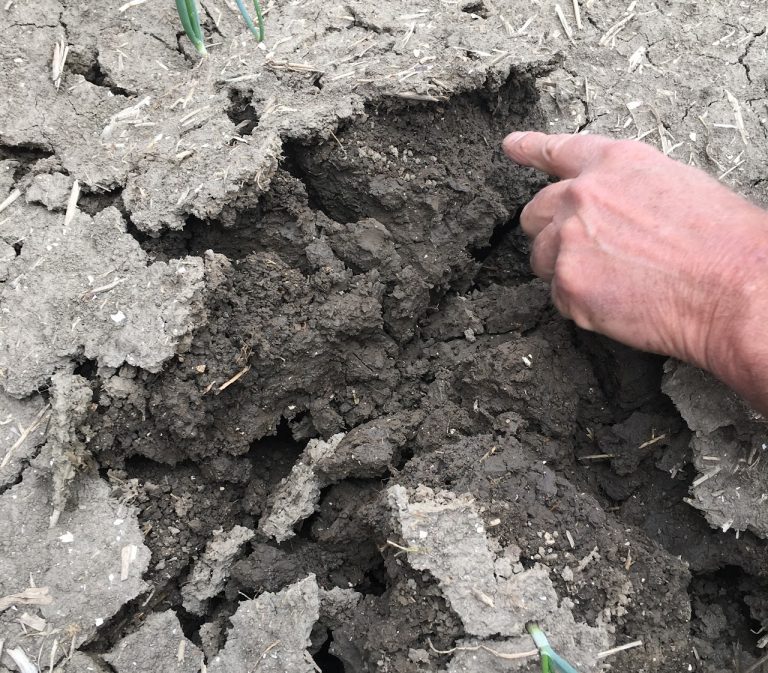Co’nn Rennen, a second generation arable farmer in the Netherlands, implements conservation agriculture techniques to reduce input requirements, improve soil structure, reduce energy costs, for potatoes, wheat, sugarbeets, and onions.
Flevoland is the newest addition to the Netherlands. Established in 1986, this island was dredged from the Ijsselmeer, and created to accommodate new land creation to the kingdom of the Netherlands. This engineering feat was met with the expansion of new cities, and large agricultural land.
It wasn’t a long drive, but it spanned old world ingenuity and new world innovation. The Netherlands, with much of its land below sea level, has no other choice than to continually dance with water and the threat of flooding. But that wasn’t always the case, The Netherland’s coast has changed so much over the past 500 some years, but that’s to be expected. They first started draining the riverbeds and marshland to make way for agricultural plots and building dijks to prevent flooding of those valuable farmlands.
Our drive took us past some of the remnants of these little islands, each field surrounded by a small creek or ‘polder’ which acts as a natural barrier for grazing sheep or cows and often divides your property from your neighbors. Amstelveen, now a bustling city-suburb of Amsterdam is along that drive, a clear example of the expanding development and the former ‘veen’ or peatland so rich in organic material lending to excellent growing conditions. A little further on our drive, and we passed Abcoude, a small village dotted with windmills and again, more of these polder lined fields, this time with herds of Holstein Friesian dairy cows. It’s an excellent representation of the countryside, not 15 minutes drive from Amsterdam’s historic city center. Along the highway drive, we pass more of these villages and adjacent farms, and it’s idyllic.
Then, we head north, and cross an unassuming bridge, into the most recent Dutch land acquisition. It didn’t exist 70 years ago, but this new island province of Flevoland, was eventually reclaiming it from what was part of the IJsselmeer.

Crossing over, and you’re quickly aware of the newness, if only from the architecture. With all cities developed in this last century, this unique modern style that departs so greatly with the farmhouses and barns that speckle the old-country. The roads are long and straight, with few turns circumventing villages, windmills and churches. The Dutch architects have done so much to make this newly acquired land attractive, with kilometers of planted forests lining the highways. Suddenly we come across the farmland. Farms here, though a fraction of the size of the large industrial commodity farms in countries like Poland, Australia and Canada, are very large for Dutch standards.
A couple of side road turns, and we’ve arrived. There’s a windmill alright, but it’s a large wind turbine, and the swoop of the blades’ whoosh is quickly forgotten. Co’nn Rennen took over his father’s farm in 2002. Almost 20 years down the line, he recounted his experiences at a recent visit to his No-Till potato, sugarbeet, onion, and wheat farm in Zeewolde. Mr. Rennen, Co’nn’s father, leased the property in 1975, as soon as the island province was inhabitable. He started with potatoes, notoriously picky with the heavy clay from the former river bottom man-made island.
“We have a lot of clay! It was the previously the bottom of the lake IJssel, what else would it be?” explained Co’nn excitedly.
The 58 ha farm has been through many changes over the nearly 50 years of its existence. With the introduction of a crop rotation in 1975 of now potatoes, wheat, and sugarbeet the farm was managed primarily by Mr. Rennen. Co’nn always knew he would take over the farm, but took his opportunity for agricultural education in Dronten, followed by an MBA in Food and Agribusiness at Wageningen. When he moved to Kazakhstan in 1993, he picked up some Russian words… “Greetings everyone!” he shouts in Russian, half joking but low and behold, there was an one in our group who too had been to the same area of Kazakhstan as he. “Incredible” he mumbled to himself, clearly entertained by the Russian exchange. He then turned to his slideshow projected on a white screen hanging from the roof of the barn.
A picnic table and a few chairs scattered around were sufficient for us, we were eager to get to the field. Following his time working at a farm in Russia, Co’nn returned with the idea to take over the farm from his father. But there was a catch: 100% autonomy on the decision making. If he bought the farm, it was his, and he would run it the way he thought best.
“The soil was packed. We had very bad compaction, and it was affecting our crops.”

Image: Co’nn Rennen pictured in front of his winter wheat crop on his farm in Zeewolde, Flevoland.
Old management techniques lead to issues with the soil structure. Lack of dedicated tire traffic lanes had tractors driving across fields. And even with low tire pressure, the weight of the machinery pressed the soil down. There was a clear moment with Co’nn decided to join up with Veldleeuwerik, a Dutch conservation agriculture consortium founded on ten indicators for success: product worth, water, biodiversity, energy, human capital, local economies, crop protection, nutrient management, soil erosion, and soil fertility. Considering the framework for conservation agriculture is (soil cover, soil erosion prevention, and crop rotation), this initiated the change for Co’nn’s farm.
Over the years it developed further. In 2002 he stopped with double cropping (planting both early and late crops) and took a hard look at the economic drivers for intensification, and the struggles he was having at the times. In 2004 Co’nn determined the current rotation and field split: 50% rest wheat, 25% potato, 12.5% onion, 12.5% sugar beet.
Here’s where it gets interesting… From 1977 to 2020, organic matter on the farm increased 0.5%. That’s not nothing, and it’s in the positive direction. He uses a green manure, consisting of 7-8 crop varieties with the majority rye. That cover crop lasts over the temperate winters, often being destroyed with the first frost. If there’s no frost, Co’nn will mechanically destroy the cover crop in January and the remains will become compost and mulch within the fields. He uses GPS for his tractor for controlled traffic, and the controlled track lanes make a huge difference in fuel savings.
“Now we ride our tractors on top of the soil, and not through it”
Prior to switching to now plough and non-dedicated track lanes, tractors would have to work their way across the fields, burning fuel at a dizzyingly slow pace. “I like to go fast, I ride my tractors at 7-8 km per hour.” Saving time and fuel. Considering most farmers plough 75% of their fields, seasonally, this offers huge potential savings in fuel expense alone.
But the magic is what’s happening within the soil. We mentioned that organic matter increased by 0.5% from 1975-2020! And Co’nn gives a lot of credit to his silent workforce: earthworms. He recounted a savvy businessman that came by his farm, wanted to take some ‘samples’ of the soil to determine the earthworm population. After digging around and counting worms for what seemed hours on end, he announced to Co’nn he had not seen so many earthworms and was eager to strike a deal to buy Co’nn’s earthworms. No deal! “They are my employees!” And he’s absolutely right, because of the earthworms, the mulching, no-plough, no-till, direct seeding, the earthworm population is thriving! The minimal soil disturbance is improving soil microbiota, soil aggregates, pore formation, and infiltration are massive. And importantly soil moisture, retained at the root-zone. “A couple of years ago we had a massive drought” Co’nn recalled, and it was massive. Resulting in excessive water being pumped from groundwater reserves, and damages to crops across the country, let alone Europe. When asked if he irrigates at all, he replies “No, we haven’t had to use the haspel (a rolling hose overhead sprayer) for years.” That’s because what he’s doing, is working.

Image: Clay soil is rich in organic matter beneath the surface crust, visible aggregates, moisture retention, and healthy soil biota life.
But what about overheads, what are the tradeoffs to implementing conservation management? There are, there’s no doubt about it. When changing management systems, there will always be learning curves, and struggles at the beginning. “At the beginning, the onions were having some difficulty, because of their weak roots.” Due to the high compaction and soil bulk density, onions couldn’t reach into the small pore spaces, and struggled the first years. The introduction of wheat helped to improve soil structure, and of course over time the mulching, cover crops, and worms worked wonders. Wheat yields are comparable to conventional, and potatoes though their yields are similar to conventional management, Co’nn sees fewer instances of bruising and an overall higher yield quality.
Conservation Agricultural practices are not widely adopted in the Netherlands, even though there is clearly a benefit of doing so. This can come down to a lack of willingness to adapt to more soil conscious practices, but with pioneers like Co’nn Rennen, we are slowing getting the word out with soil conservation management successes. With more and more pressure coming from Dutch and European agricultural policy, the focus on soil health, carbon sequestration, growers are faced with tough decisions moving forward. But with clear examples of conventional farming, with conservation techniques, steps can be made for the benefit of soil, farmer, and society.

